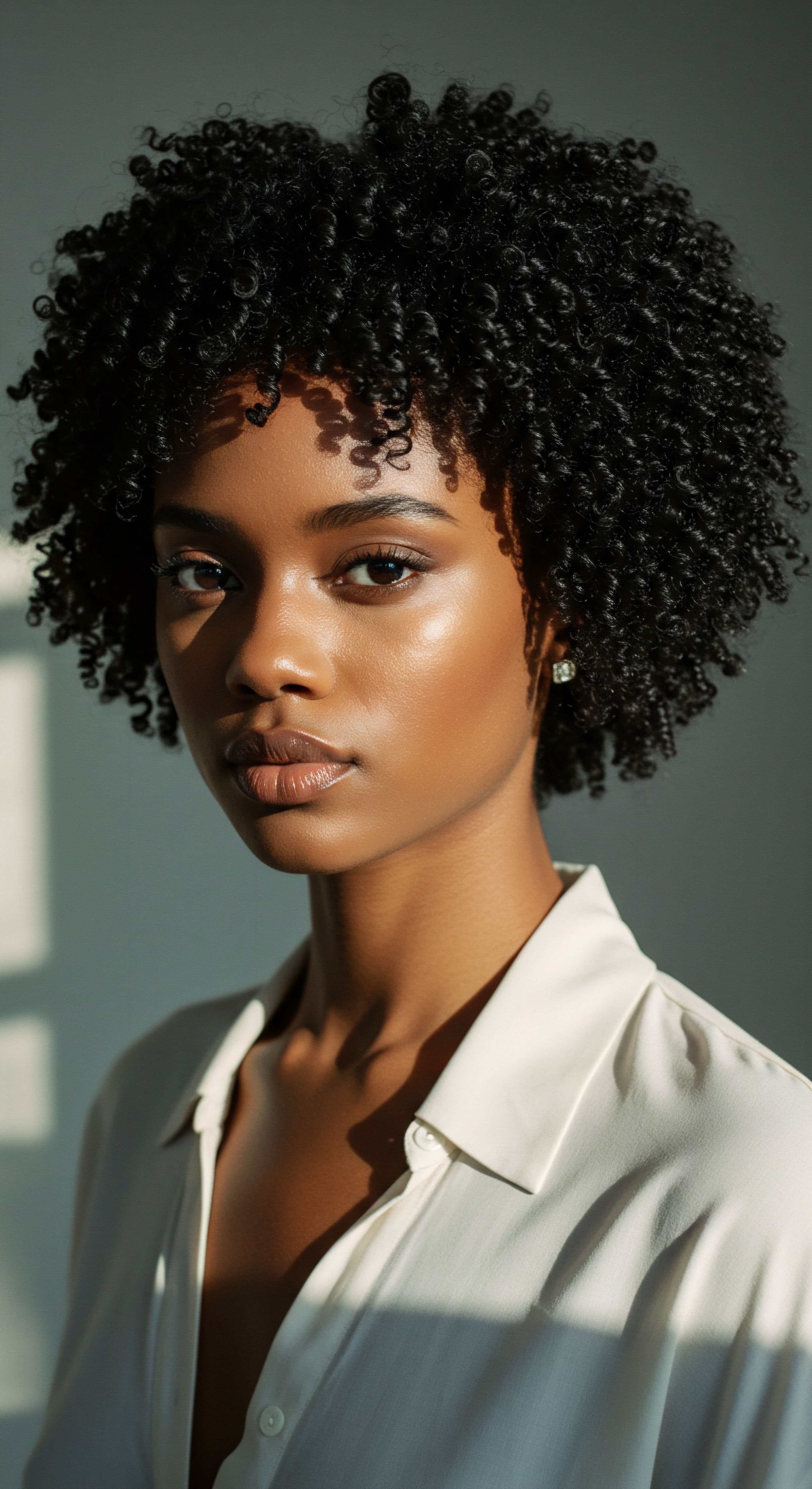
Roots
There exists a quiet language within our strands, a whisper of their inner workings that often goes unheard amidst the daily rhythms of care. Have you ever paused to truly listen to what your hair communicates, particularly when it drinks in moisture or when it springs back with a joyful resilience? This deep inquiry into our hair’s foundational characteristics invites us to consider how its very structure dictates its behavior, a journey into the elemental understanding of its needs. The relationship between hair’s ability to absorb and retain water, known as porosity, and its capacity to stretch and return, or elasticity, forms a core dialogue in this conversation.

Hair’s Outer Shield and Inner Core
The outermost layer of each hair strand, the Cuticle, resembles a series of overlapping scales, much like shingles on a roof. These delicate, flattened cells serve as the primary gatekeepers, controlling the passage of moisture into and out of the hair’s inner sanctum. Beneath this protective shield lies the Cortex, a complex bundle of keratin proteins that give hair its strength, flexibility, and shape. The cortex is where the magic of elasticity truly resides, allowing hair to bend, stretch, and recoil without breaking.
The integrity of the cuticle directly influences how well the cortex is protected and, consequently, how well hair maintains its natural bounce and pliability. When these cuticle scales lie flat and smooth, they create a tight barrier, leading to lower porosity. Conversely, when they are raised or damaged, they allow for greater absorption, resulting in higher porosity.

Understanding Porosity’s Many Faces
Hair porosity is not a singular, static state; it exists along a spectrum, reflecting the unique journey of each strand. We often categorize it into three main types:
- Low Porosity Hair ❉ This hair type presents with tightly bound cuticle layers. Water and products struggle to enter the hair shaft, often beading on the surface before slowly penetrating. Once moisture does gain entry, however, it tends to stay, making this hair type prone to product build-up if heavier formulations are used. The challenge here is to invite hydration in.
- Medium Porosity Hair ❉ This type generally exhibits a balanced cuticle structure, allowing for efficient moisture absorption and retention. It is often considered the ideal state, as it responds well to most products and styling techniques, maintaining a healthy moisture balance with relative ease.
- High Porosity Hair ❉ Characterized by more open, raised, or even damaged cuticle layers, this hair readily absorbs water. While this might seem advantageous, it also means moisture escapes just as quickly, leaving strands feeling dry, prone to frizz, and vulnerable to damage. This openness can be a result of genetics or external factors.
The very structure of textured hair, with its natural bends and coils, often means a more exposed cuticle surface compared to straighter hair types. This inherent characteristic can lead to textured hair leaning towards higher porosity, making the dance of moisture balance a constant, mindful practice.

Elasticity The Hair’s Spring
Elasticity is the hair’s graceful ability to stretch without breaking, then return to its original form. Picture a healthy rubber band; it stretches far and snaps back perfectly. Hair with good elasticity feels supple, responds well to manipulation, and resists breakage during styling and detangling.
When elasticity is compromised, hair can feel brittle, stiff, or even mushy when wet, stretching excessively and failing to recoil, eventually leading to snapping. This delicate balance of strength and flexibility is vital for maintaining the vibrancy and integrity of textured strands, which undergo significant manipulation during daily care and styling.
Hair’s outer cuticle acts as a gatekeeper, determining its porosity, while the inner cortex grants it elasticity, forming a vital connection for strand health.
The internal structure of the hair, particularly the keratin proteins within the cortex, plays a decisive role in this attribute. These proteins are arranged in a specific way that allows for this stretching and recoiling action. When hair is well-hydrated and its protein structure is intact, it exhibits optimal elasticity. Damage to the cuticle, which affects porosity, can indirectly impact elasticity by leaving the delicate cortex exposed to environmental stressors and mechanical friction, gradually eroding its structural integrity.

The Interplay of Porosity and Elasticity
The connection between porosity and elasticity is deeply interwoven, a silent conversation within each strand. Hair that is highly porous, with its open cuticles, is more susceptible to rapid moisture loss. This constant flux of hydration, known as Hygral Fatigue, can place immense stress on the hair’s internal protein bonds, leading to a gradual decline in elasticity. Imagine a sponge repeatedly soaking up and releasing water; over time, its structure can weaken.
Similarly, hair that cannot maintain a stable moisture level becomes more fragile, less able to stretch, and more prone to breakage. Conversely, low porosity hair, while adept at retaining moisture once it penetrates, can suffer from chronic dryness if it struggles to absorb water initially. This persistent lack of adequate hydration can also render hair brittle and stiff, thereby reducing its elasticity over time. The key, then, lies in understanding how to harmonize these two characteristics, ensuring hair receives and holds the right amount of moisture to preserve its natural spring and resilience.

Ritual
Stepping into the realm of daily care, we discover that our intentional actions hold profound influence over the delicate balance of our hair’s porosity and elasticity. This segment moves beyond mere identification, inviting us to consider how our hands, our choices, and our routines shape the very resilience of our strands. It is a shared space of practical wisdom, where the gentle guidance of informed practice becomes a pathway to truly responsive hair. The rituals we perform, from cleansing to conditioning, are not simply tasks; they are opportunities to nurture the hair’s inherent spring and its capacity to receive sustenance.
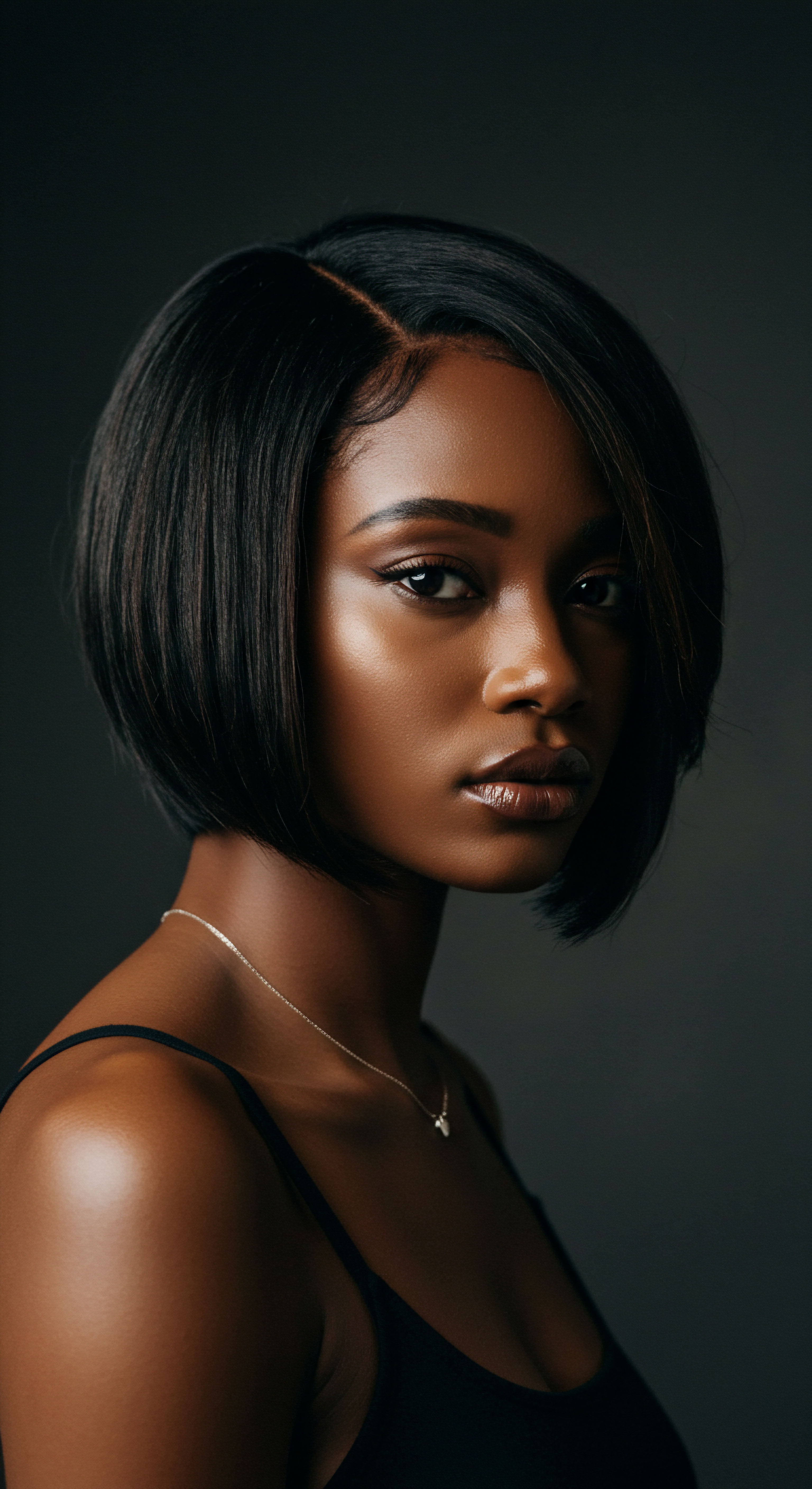
Does Hair Porosity Change Over Time?
Indeed, hair porosity is not a fixed characteristic; it can evolve through life’s experiences. While genetics play a foundational role in determining our initial porosity, external factors and daily practices significantly influence its shifts. Chemical treatments, such as coloring, bleaching, or relaxing, forcefully lift the cuticle layers to alter the hair’s internal structure, inevitably increasing porosity. Excessive heat styling, through tools like flat irons and curling wands, can also damage the cuticle, creating microscopic gaps that lead to higher porosity.
Even environmental exposures, like prolonged sun exposure or harsh winds, contribute to cuticle damage and a more open structure. Recognizing these influences allows us to approach our care routines with a deeper understanding of how our choices shape our hair’s present and future state.
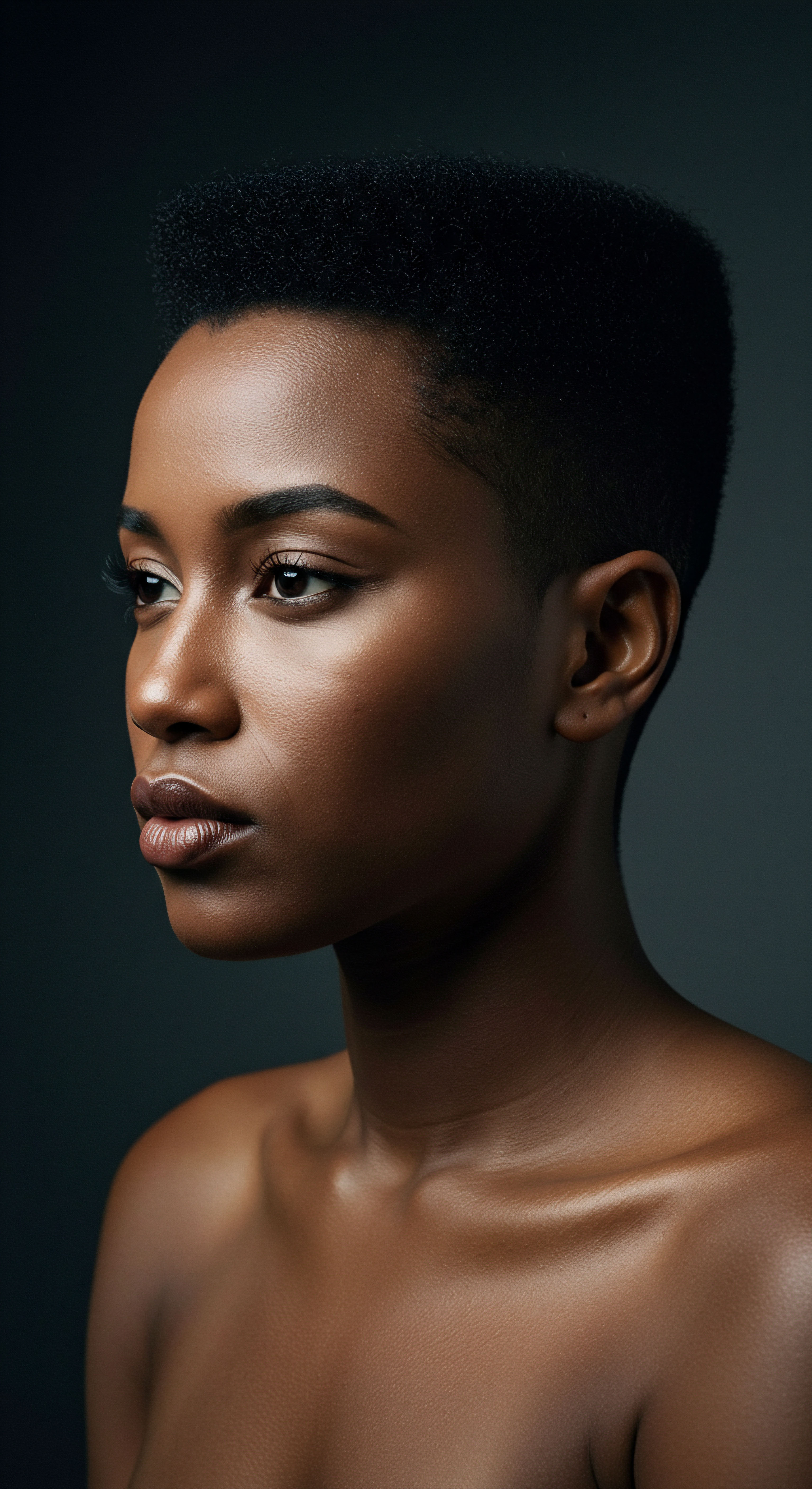
Tailoring Cleansing for Porosity
The act of cleansing, seemingly straightforward, holds a nuanced power when approached with porosity in mind. For those with Low Porosity Hair, the goal is to gently encourage the cuticle to open just enough to receive moisture without stripping essential oils. Lightweight, sulfate-free shampoos that cleanse without leaving heavy residues are ideal. Consider using warm water during washing, as its gentle warmth can help lift the cuticle slightly, making it more receptive to subsequent conditioning.
For High Porosity Hair, the focus shifts to preserving moisture during cleansing. Creamy, moisturizing shampoos or co-washes that minimize cuticle disturbance are beneficial. Cooler water rinses can help to smooth down the cuticle, sealing in hydration and preparing the hair for further conditioning treatments. The rhythm of washing also matters; less frequent cleansing can be a gentle practice for porous strands.

Conditioning to Bolster Elasticity
Conditioning is a cornerstone of hair health, particularly for elasticity. Deep conditioners, rich in humectants and emollients, are essential for all porosity types but serve different purposes. For Low Porosity Hair, deep conditioning with the aid of gentle heat (like a steam cap or warm towel) can significantly improve product penetration, allowing nourishing ingredients to reach the cortex and enhance elasticity. Without this warmth, products may simply sit on the surface.
For High Porosity Hair, protein treatments become particularly valuable. Proteins, especially hydrolyzed forms, can temporarily fill the gaps in compromised cuticles, strengthening the hair shaft and providing a scaffolding that supports elasticity. However, balance is paramount; too much protein without adequate moisture can lead to stiffness and brittleness, paradoxically reducing elasticity. A consistent regimen that alternates between protein-rich and moisture-rich deep conditioners often yields the most favorable results for hair that struggles with moisture retention.
Intentional care rituals, from gentle cleansing to thoughtful conditioning, directly influence hair’s porosity and its inherent elasticity.
The selection of ingredients also holds sway. For instance, a 2023 study published in the Journal of Cosmetic Dermatology found that fermented hair care products significantly improved hair elasticity for those with high porosity, with fermented rice water increasing hair elasticity by 35%. This highlights the subtle yet powerful impact of innovative ingredient choices in addressing specific porosity needs and enhancing hair’s natural spring.
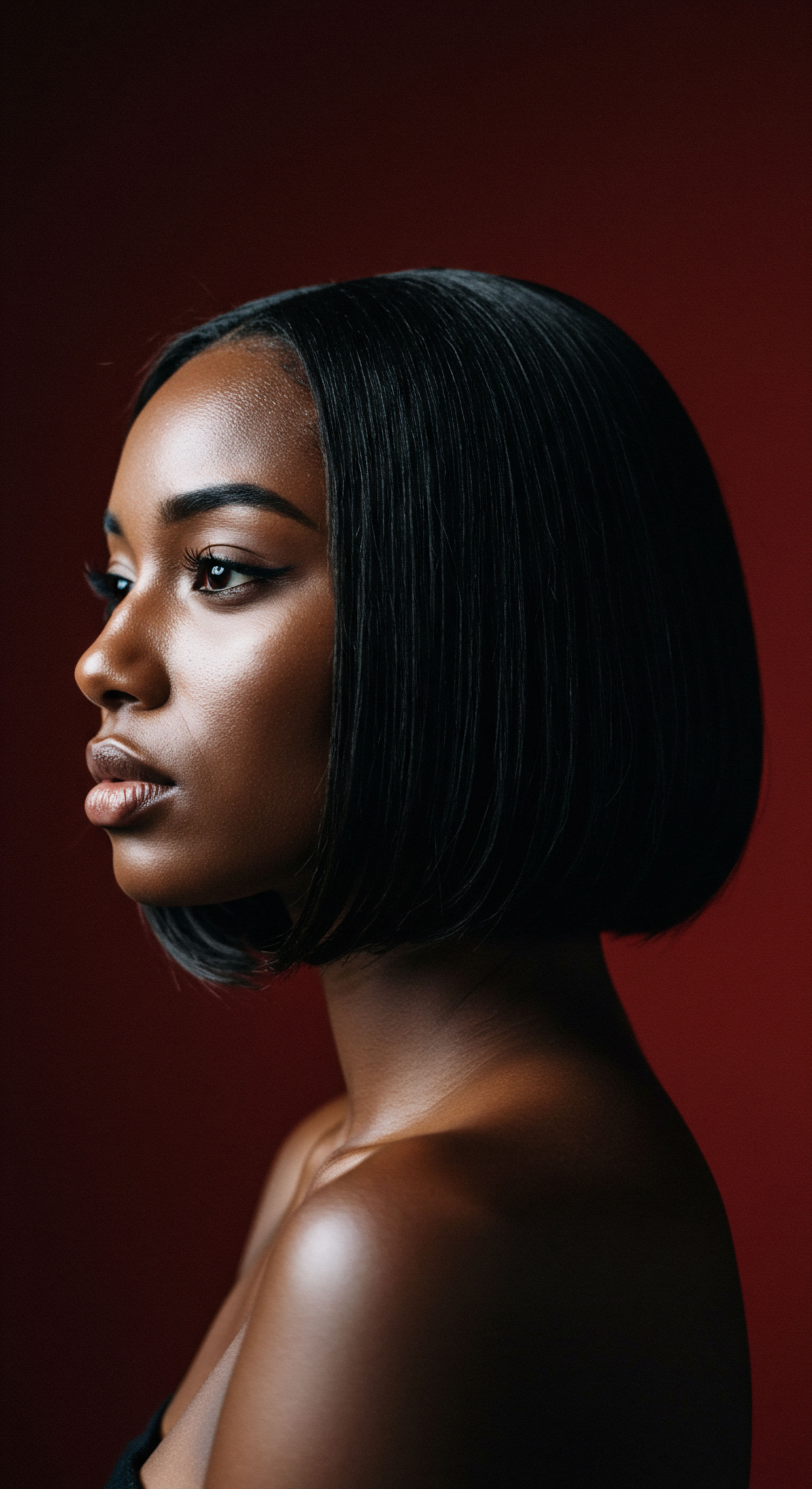
Sealing and Protecting for Lasting Resilience
Once moisture has been introduced, the next step is to seal it within the hair shaft to prolong hydration and protect elasticity. This is where emollients and occlusives truly shine. For High Porosity Hair, heavier oils and butters can create a protective barrier that minimizes rapid water loss. The Liquid, Oil, Cream (LOC) Method or Liquid, Cream, Oil (LCO) Method are popular layering techniques that effectively seal moisture into highly porous strands, contributing to their sustained elasticity.
For Low Porosity Hair, lighter oils are preferred to avoid weighing down the hair or causing build-up, which can also hinder flexibility. Beyond products, protective styling plays a crucial role. Styles that minimize manipulation, such as braids, twists, or buns, reduce the mechanical stress on hair, helping to preserve its cuticle integrity and, by extension, its elasticity. Protecting hair during sleep with satin bonnets or pillowcases also minimizes friction, a common culprit behind cuticle damage and compromised elasticity.
| Hair Porosity Type Low Porosity |
| Cleansing Approach Lightweight, sulfate-free shampoos; warm water. |
| Conditioning Focus Deep conditioners with heat; humectant-rich. |
| Sealing & Protection Lighter oils; avoid heavy butters; gentle detangling. |
| Hair Porosity Type Medium Porosity |
| Cleansing Approach Balanced, moisturizing shampoos. |
| Conditioning Focus Standard deep conditioning; balanced protein/moisture. |
| Sealing & Protection Medium-weight oils; flexible styling. |
| Hair Porosity Type High Porosity |
| Cleansing Approach Creamy co-washes; cooler water rinses. |
| Conditioning Focus Protein treatments (balanced); moisture-rich deep conditioners. |
| Sealing & Protection Heavier oils/butters; LOC/LCO method; protective styles. |
| Hair Porosity Type Adapting care to porosity can significantly improve hair elasticity and overall health. |
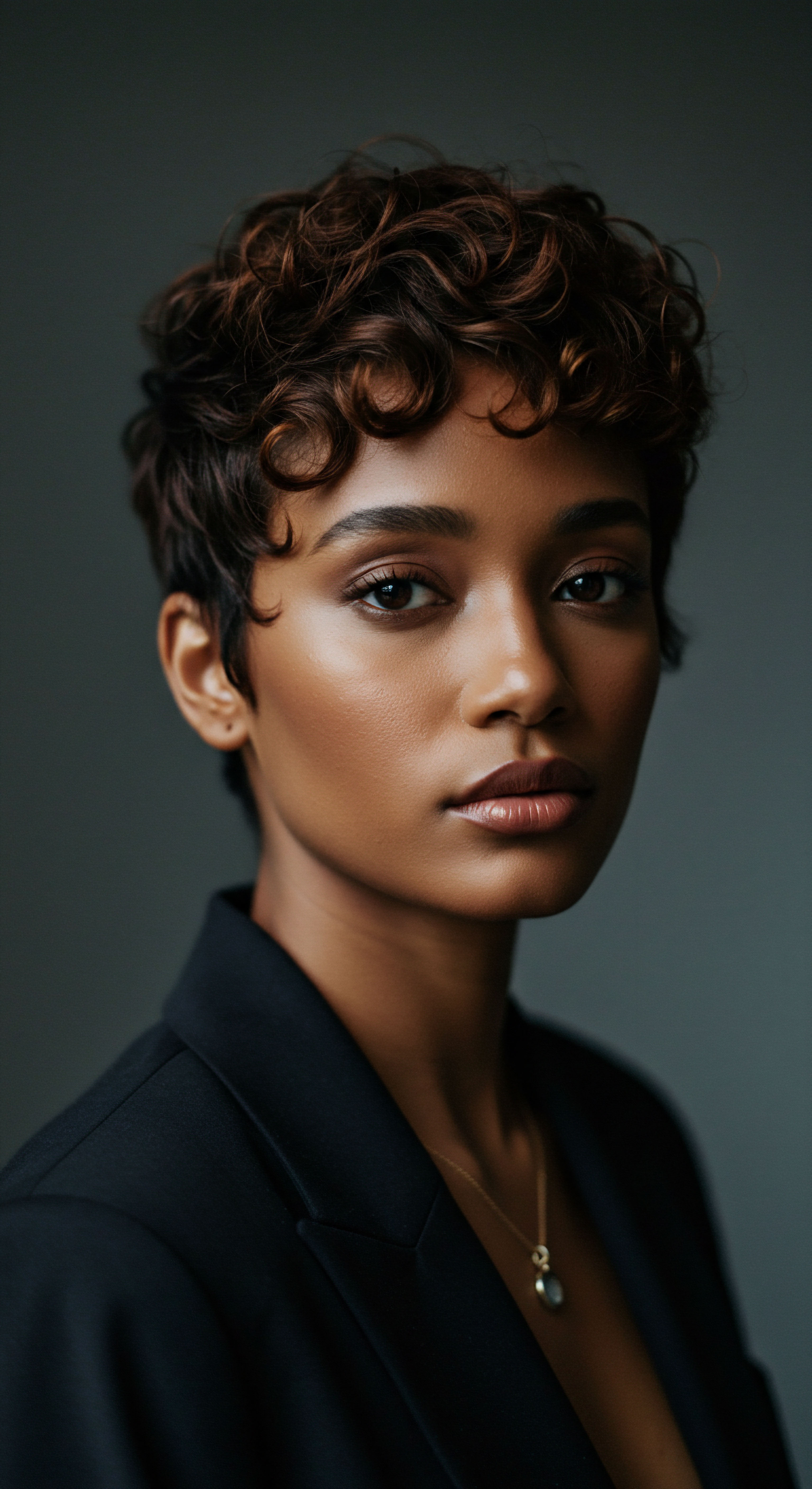
Relay
How deeply do the unseen forces of our environment, our ancestral legacies, and even the very water we use shape the elasticity of our textured hair? This section invites us to look beyond the obvious, delving into the more intricate and interconnected factors that influence the dance between porosity and elasticity. It is a space for profound insight, where scientific understanding meets the wisdom of lived experience, revealing the subtle yet powerful mechanisms at play. We will examine how external elements and internal compositions orchestrate the hair’s ability to stretch and rebound, revealing a tapestry of influences far richer than surface observation suggests.
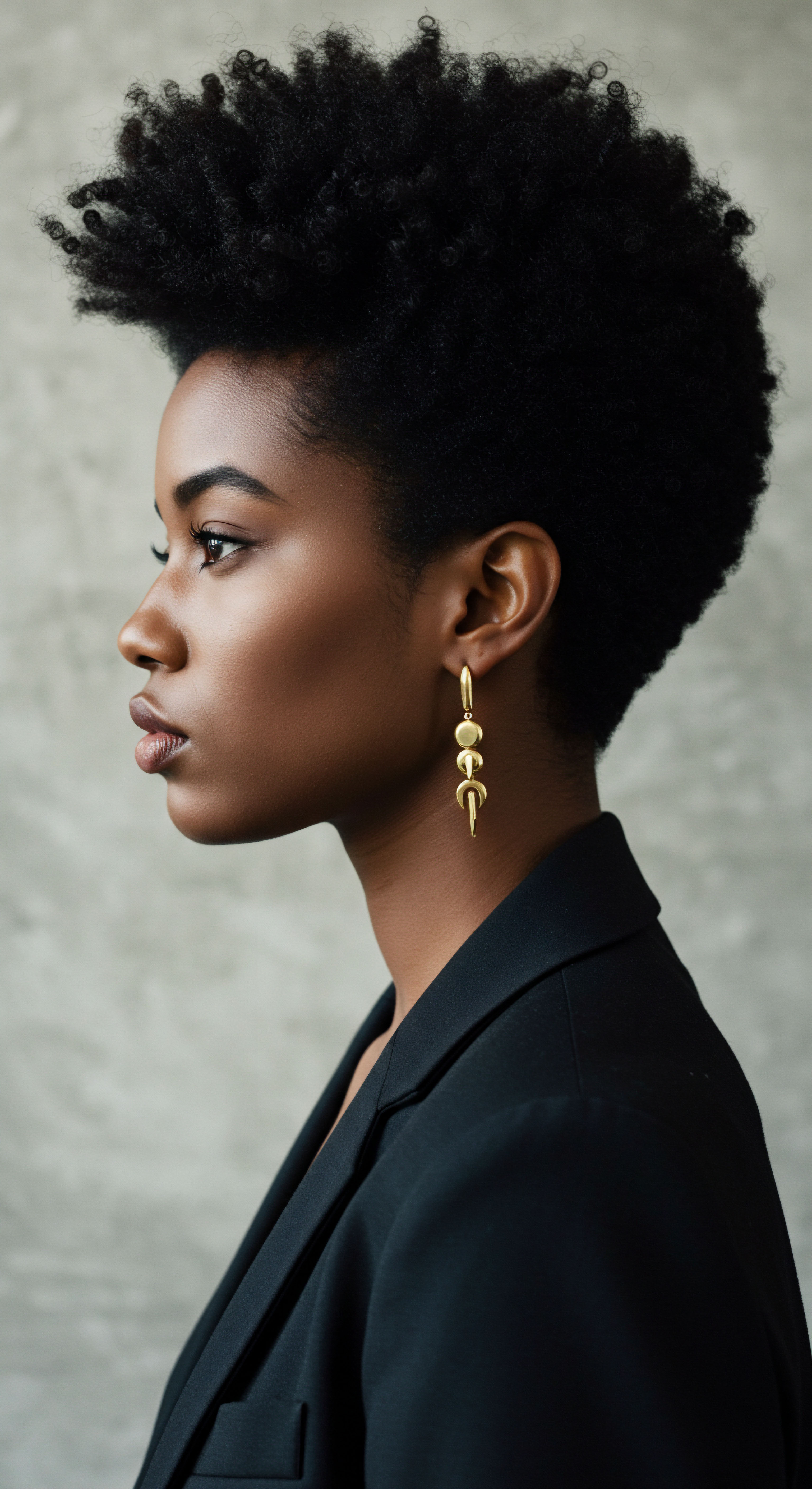
The Chemical Equation of Hair’s Spring
At a microscopic level, hair elasticity is a testament to the complex arrangement of keratin proteins within the cortex. These proteins are linked by various bonds, most notably disulfide bonds, which contribute significantly to hair’s strength and resilience. When hair is healthy and well-hydrated, these bonds allow the hair to stretch and return to its original state. However, chemical processes like bleaching, perming, or relaxing fundamentally alter these bonds, often breaking them down and reforming them in new configurations.
This chemical manipulation, while achieving desired style changes, inevitably increases the hair’s porosity by lifting or damaging the cuticle. This heightened porosity then makes the hair more vulnerable to moisture loss and further structural weakening, directly impacting its ability to recoil. The resulting reduction in elasticity can manifest as a gummy, weak feel when wet, or a dry, brittle texture when dry, leading to increased breakage.
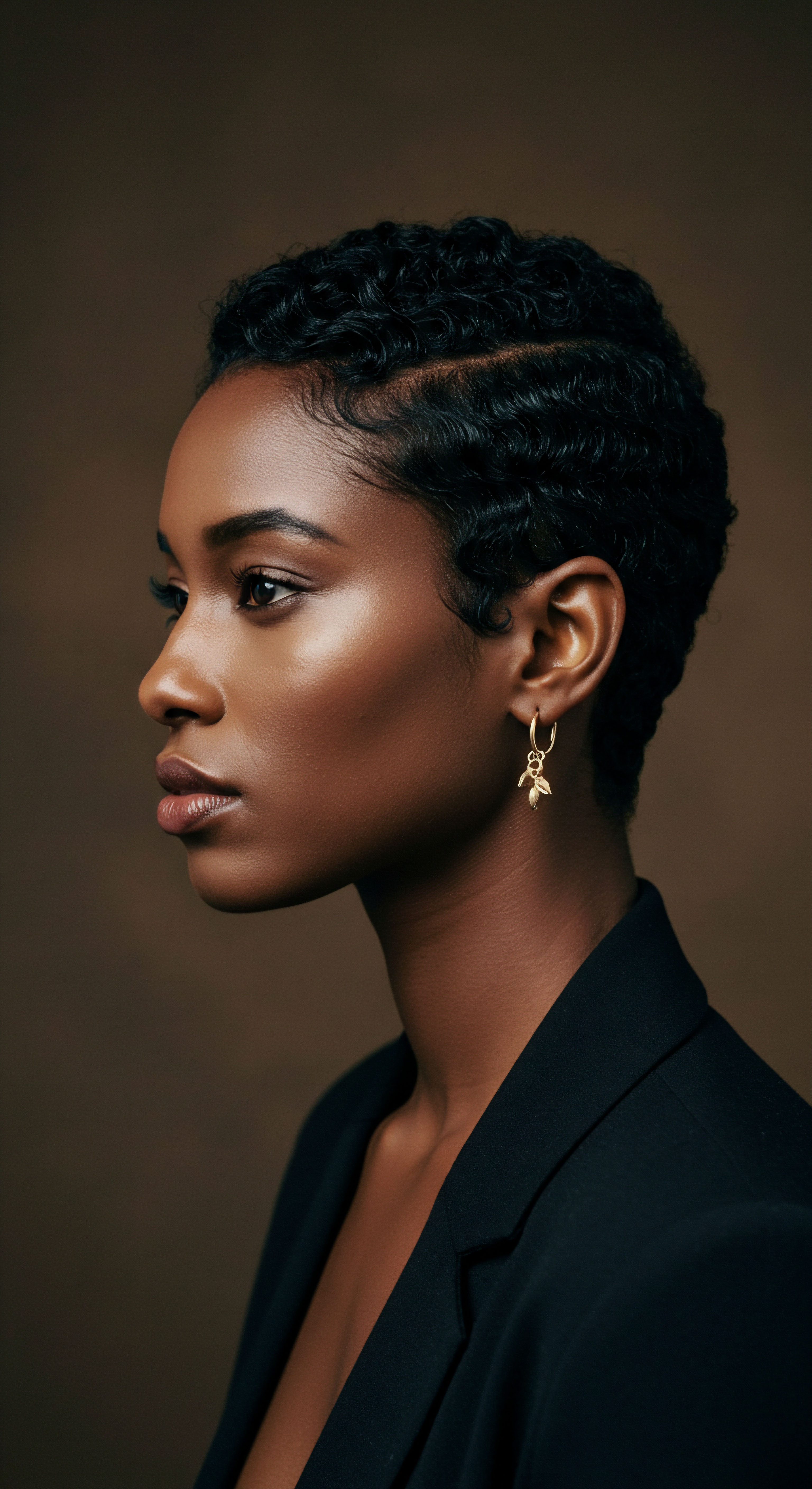
How Does Water Quality Affect Hair Elasticity?
The very water we use to cleanse our hair carries a silent impact on its porosity and elasticity. Hard Water, laden with minerals like calcium and magnesium, can deposit these residues onto the hair shaft. Over time, this mineral build-up creates a film that can hinder moisture absorption, effectively mimicking low porosity characteristics, even if the hair’s natural porosity is different. This external coating can also make hair feel stiff and less pliable, directly affecting its elasticity.
Conversely, very soft water, while less prone to mineral build-up, can sometimes leave hair feeling overly slick, potentially making it harder to rinse products thoroughly, which could lead to a different kind of build-up that also impacts elasticity over time. Understanding the mineral content of your water, perhaps through a simple test, allows for a more informed approach to cleansing and conditioning, potentially influencing the longevity of your hair’s spring.
The concept of Hygral Fatigue merits deeper consideration here. This phenomenon describes the stress placed on hair due to repeated swelling when wet and contracting when dry. High porosity hair, with its readily open cuticles, is particularly susceptible to this cycle. As water rushes in, the hair swells, and as it dries, it shrinks.
This constant expansion and contraction can gradually weaken the hair’s internal structure, leading to a significant loss of elasticity over time. This is why practices that minimize prolonged wetness or excessive wetting and drying cycles, such as gently blotting hair dry or opting for less frequent washes for highly porous strands, are beneficial in preserving hair’s inherent spring.

The PH Balance and Hair’s Inner Strength
The pH level of hair and the products we apply plays a critical, yet often overlooked, role in maintaining both porosity and elasticity. Hair is naturally acidic, typically falling within a pH range of 4.5 to 5.5. This slightly acidic environment helps to keep the cuticle scales lying flat and smooth, thus maintaining optimal porosity and protecting the inner cortex. Products that are too alkaline (with a high pH) can cause the cuticle to swell and lift, increasing porosity and leaving the cortex exposed.
This exposure makes the hair more vulnerable to damage, directly compromising its elasticity. Consider a notable study from the International Journal of Cosmetic Science in 2018, which illuminated a crucial aspect for textured hair ❉ 80% of Participants with High Porosity Hair, Specifically African American Women, Presented with a Scalp PH above 5.5. This Alkalinity Directly Contributed to a Weakened Hair Shaft. When the PH was Lowered to a More Acidic Range of 4.5-5.0, a Significant 35% Improvement in Hair Strength and Elasticity was Observed. This compelling data point underscores the profound impact of pH balance on hair’s structural integrity and its ability to rebound. Utilizing pH-balanced products, especially after chemical treatments, becomes a powerful tool in preserving hair’s natural resilience.

Beyond the Surface ❉ The Cortex and Its Pliability
While the cuticle dictates porosity, the Cortex is the true seat of elasticity. This layer is primarily composed of keratin proteins, which are helical in shape and arranged in a complex matrix. These helices coil and uncoil when stretched, allowing the hair to extend and then recoil. The integrity of these protein structures and the bonds that hold them together are paramount for healthy elasticity.
Factors that degrade these internal proteins, such as severe chemical damage, extreme heat, or even certain nutritional deficiencies, will directly reduce elasticity, regardless of porosity. When the cortex is compromised, hair loses its ability to spring back, becoming limp, brittle, or even gummy. This emphasizes that while managing porosity is vital for protection, the health of the cortex remains the ultimate determinant of hair’s true elasticity.
The concept of Protein-Moisture Balance is central to maintaining cortical health. Hair needs both protein for strength and moisture for flexibility. A deficit in either can compromise elasticity.
Too much protein without sufficient moisture can make hair stiff and prone to breakage, while too much moisture without adequate protein support can lead to a mushy, overly stretchy texture that also breaks easily. Finding the right equilibrium, often through a combination of protein treatments and deep conditioning, is a personalized journey that allows the cortex to function optimally, preserving the hair’s natural spring.
- Hair Structure and Damage ❉ The outer Cuticle protects, while the inner Cortex provides elasticity. Damage to the cuticle from chemicals or heat increases porosity and exposes the cortex, weakening hair’s ability to stretch and recoil.
- Water’s Hidden Influence ❉ Hard Water minerals can coat hair, hindering moisture absorption and making hair feel stiff, affecting elasticity.
- PH and Hair Health ❉ Maintaining hair’s natural acidic PH (4.5-5.5) helps keep cuticles smooth, supporting healthy porosity and elasticity.
| Factor Chemical Treatments |
| Impact on Elasticity Break down internal protein bonds, reducing elasticity. |
| Relevance to Textured Hair Relaxers and permanent colors significantly alter structure. |
| Factor Heat Styling |
| Impact on Elasticity Denatures proteins, leading to brittleness and loss of spring. |
| Relevance to Textured Hair High heat can cause irreversible damage, especially without protection. |
| Factor Environmental Stressors |
| Impact on Elasticity UV radiation and pollution degrade protein, compromising flexibility. |
| Relevance to Textured Hair Exposure can accelerate cuticle damage and elasticity loss. |
| Factor pH Imbalance |
| Impact on Elasticity Alkaline products lift cuticles, weakening the hair shaft. |
| Relevance to Textured Hair Many traditional products can be alkaline, requiring pH-balancing care. |
| Factor Internal Protein Health |
| Impact on Elasticity Directly responsible for the hair's ability to stretch and recoil. |
| Relevance to Textured Hair Adequate protein intake and topical application are vital. |
| Factor Elasticity is a multifaceted property, influenced by both external care and the hair's intrinsic health. |
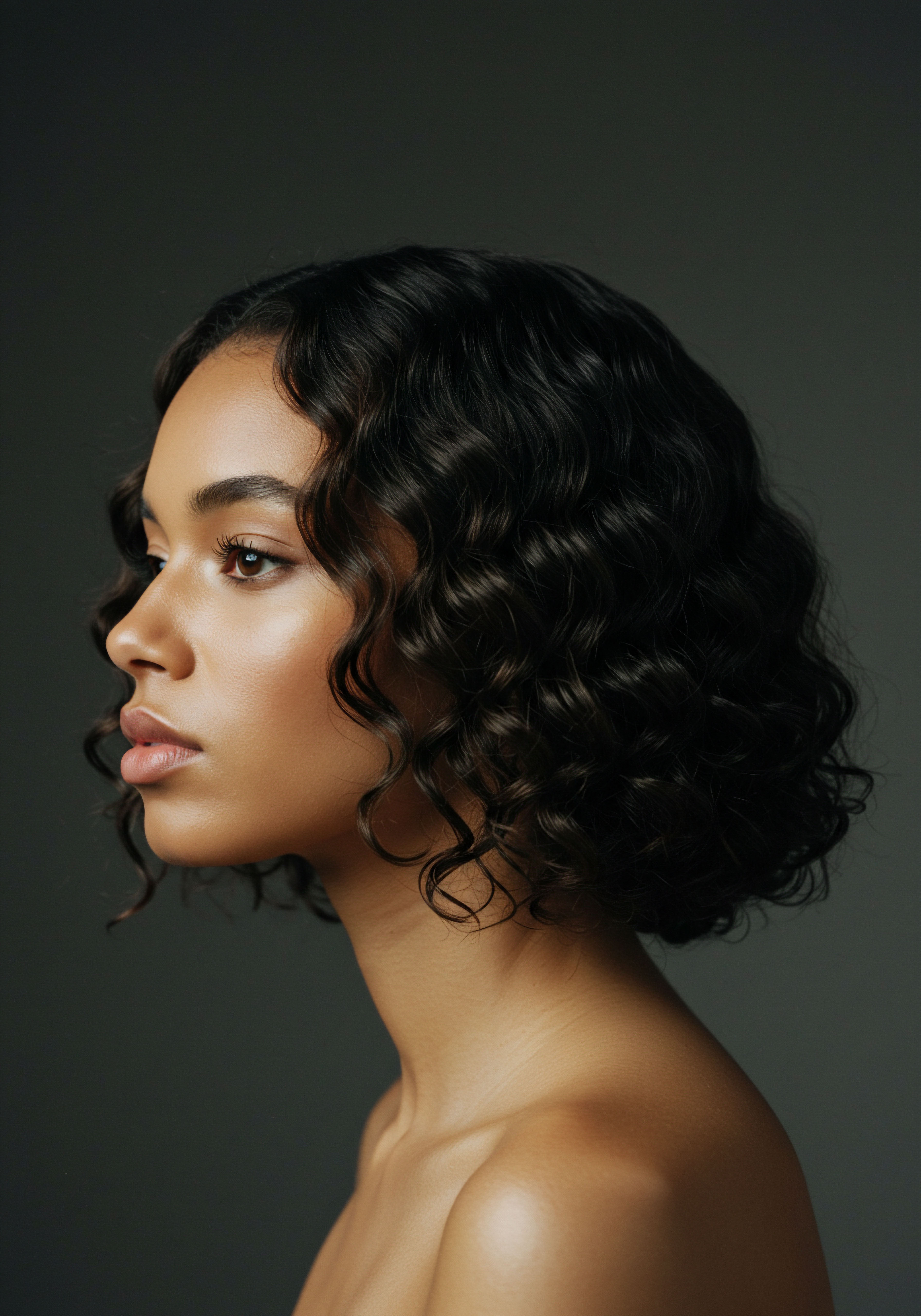
Reflection
As we journey through the intricate world of hair, from the foundational whispers of its structure to the profound influences of our rituals and the subtle dance of environmental factors, a singular truth emerges ❉ our hair is a living story, constantly responding to the world around it and the care we bestow upon it. The connection between porosity and elasticity, far from being a simple cause-and-effect, reveals itself as a complex, interconnected relationship, a testament to the hair’s remarkable capacity for adaptation and resilience. Understanding these fundamental characteristics empowers us not to control, but to harmonize with our strands, offering them the precise balance of moisture and strength they yearn for. It is a gentle invitation to observe, to learn, and to honor the unique narrative woven into every curl, coil, and wave, allowing our textured hair to truly flourish in its own authentic brilliance.

References
- Dias, T. (2004). Hair Cosmetics ❉ An Overview. International Journal of Cosmetic Science, 26(3), 105-112.
- Robbins, C. R. (1994). Chemical and Physical Behavior of Human Hair. Springer-Verlag.
- Wagner, R. & Joekes, I. (2005). Hair Fiber Characteristics and Methods to Evaluate Hair Physical and Mechanical Properties. Brazilian Journal of Pharmaceutical Sciences, 41(2), 173-182.
- Syed, A. N. (2002). Correlating Porosity to Tensile Strength. Cosmetics & Toiletries, 117(11), 57-62.
- Davis-Sivasothy, A. (2011). The Science of Black Hair. Saja Publishing Company.
- Evans, T. (2008). Adsorption Properties of Hair. Practical Modern Hair Science.
- Johnson, A. M. et al. (2020). Genetic Factors Influencing Hair Texture and Porosity in African American Women. Journal of Cosmetic Dermatology, 19(4), 867-873.
- Marcelin, R. et al. (2024). New OU research aims to improve wellbeing and reduce health risks for people with curly hair. The Open University.
- Park, K. et al. (2020). How Hair Damage and Hair Repair Treatments Affect Water Uptake into Hair and Hair Swelling. Poster Presentation at TRI/ITC Multi-Ethnic Hair and Scalp Care Symposium.
- Sewraj, P. et al. (2020). Understanding the Underlying Mechanisms of Hair Damage in African Hair. Key-note Presentation at TRI/ITC Multi-Ethnic Hair and Scalp Care Symposium.
- Wortmann, F.-J. et al. (2016). DSC of Human Hair ❉ A Tool for Claim Support or Incorrect Data Analysis? International Journal of Cosmetic Science, 38(5), 433-439.
- Al-Darbi, M. et al. (2006). The Outside Surfaces of a Hair Contains Overlapping Scales that Can Absorb as Much Moisture as 35% of the Hair’s Mass. Journal of Cosmetic Science, 57(3), 185-195.
- Destaillats, F. et al. (2011). Identification of D6-monounsaturated fatty acids in human hair and nail samples by gas-chromatography-mass-spectrometry using ionic-liquid coated capillary column. Journal of Chromatography A, 1218(50), 9384-9390.
- Popescu, C. & Gummer, C. (2016). DSC of Human Hair ❉ A Tool for Claim Support or Incorrect Data Analysis? International Journal of Cosmetic Science, 38(5), 433-439.
- Marcelin, R. & Bowen, J. (2024). New OU research aims to improve wellbeing and reduce health risks for people with curly hair. The Open University.